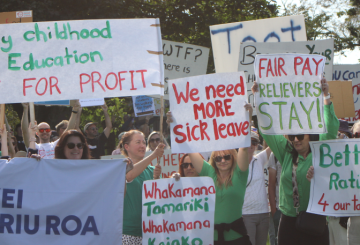Học sinh trường học trên khắp đất nước đã có một khởi đầu vượt trội so với người lớn bằng cách tham gia vào một cuộc bầu cử giả. Khoảng 115.000 học sinh từ 775 trường đã bỏ phiếu cho các đảng và ứng cử viên cử tri địa phương phản ánh cuộc tổng tuyển cử thực tế. Ủy ban bầu cử đã tạo điều kiện cho sáng kiến này bằng cách cung cấp cho các trường học thiết bị bỏ phiếu.
Cuộc bầu cử giả của Trường Trung cấp Remuera cho thấy Sameer quản lý hàng đợi học sinh bỏ phiếu, mô tả quá trình này là đơn giản. Norah, một phần của nhóm công khai của trường, đã tiết lộ những ý kiến trái chiều về việc liệu thanh thiếu niên có nên được phép bỏ phiếu hay không. Trong khi một số người tin rằng thanh thiếu niên thiếu hiểu biết đầy đủ về quá trình bầu cử, những người khác cảm thấy họ nên được quyền bỏ phiếu. Maelee, một sinh viên khác, bày tỏ sự nhiệt tình với việc bỏ phiếu khi cô bước sang tuổi 18 và nhấn mạnh tầm quan trọng của việc tham gia bỏ phiếu nhiều hơn, đặc biệt là trong giới trẻ Māori và Pasifika.
Giáo viên của trường, Julie Miller, nhấn mạnh tầm quan trọng của giáo dục bầu cử sớm. Cô nói, “Chạy nó như thế này có nghĩa là họ chuẩn bị và tham gia hơn rất nhiều vào tương lai.” Anusha Guler từ Ủy ban Bầu cử chỉ ra sự tham gia thấp của thanh niên trong các cuộc bầu cử, nói rằng nhận thức sớm có thể thúc đẩy sự tham gia.
Học sinh bày tỏ lòng biết ơn đối với chương trình Bỏ phiếu Trẻ em, mà họ cảm thấy đã đóng góp đáng kể vào sự quan tâm của họ đối với cuộc bầu cử. Chương trình dạy họ về hoạt động của Nghị viện, bầu cử chính phủ và quyền tự do lựa chọn trong việc bỏ phiếu. Luka, một trong những sinh viên, nhấn mạnh tầm quan trọng của việc lựa chọn nhà lãnh đạo quốc gia và khuyến khích nhiều người bỏ phiếu hơn.
Tuy nhiên, khi được hỏi về các lựa chọn bầu cử giả của họ, Sameer và William vẫn khắt khe. Kết quả từ cuộc bỏ phiếu của sinh viên sẽ được công bố sau khi kết quả bầu cử chính thức được công bố.




























































